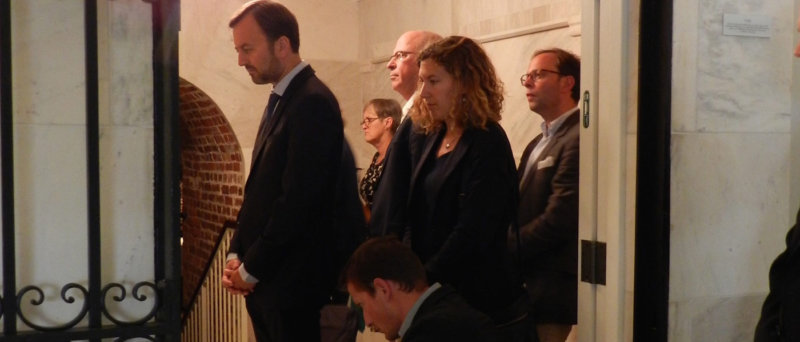The mayor of Saint-Omer looked closely at the engraving of Baltimore’s first archbishop, John Carroll, and his face lit up.
The double-armed cross on the bishop’s stole was part of the town’s crest, he told Archbishop William E. Lori during a visit to the Basilica of the National Shrine of the Assumption of the Blessed Virgin Mary and the archbishop’s residence.
Mayor Francois Decoster wondered aloud if the symbol was a remembrance of John Carroll’s years at Saint-Omer, a town in the north of France, admitting it was speculation. “It sounds like well-founded speculation,” said his host, Archbishop Lori, who pointed out the same symbol on another Carroll engraving.
Connections between Saint-Omer and Maryland stretch back nearly 275 years to the year when Daniel was the first of three Carroll sons to sail to France to begin six years of study at the Jesuit school in Saint-Omer.
Its mayor said after the Aug. 20 visit that Saint-Omer seeks to build a relationship with the home state of the Carroll family, including student exchanges and cultural programs.
“We want to foster that,” he said, noting the long religious history of his town, which was home to an ancient abbey, a cathedral, and schools run by both French and English Jesuits.
Members of the delegation from Saint-Omer came to Baltimore on the last day of their weeklong trip to the U.S.
After visiting French embassies in New York and Washington, D.C., they met with Lt. Gov. Boyd Rutherford and representatives of Georgetown University in Washington, D.C., and The John Carroll School in Bel Air to outline their plan for marking the Carroll connection, according to Nicolas Rochas, head of international relations for the Saint-Omer region.
“We’re making a lot of connections,” he said.
Saint-Omer became the home of an English Jesuit college after exercise of the Catholic faith was banned in Great Britain.
According to town’s Carroll Project report, the school educated more American students than both Cambridge and Oxford at that time. They included Daniel Carroll, signer of the U.S. Constitution and the first to attend Saint-Omer in 1742; Charles Carroll of Carrollton, the only Catholic signer of the Declaration of Independence; and John Carroll, first bishop of the United States.
Between now and 2017, Saint-Omer officials propose cultural exchanges between French and American schools, scientific research, creation of statues of the Carrolls for both Saint-Omer and a U.S. location, and a traveling exhibition of Saint-Omer in the Carrolls’ time.
In 2017, they plan to mark the 275th anniversary of Daniel Carroll’s arrival with the reopening of the newly restored Jesuit chapel, as well as a concert, symposium and art exhibition.
The vast 1615 chapel served as part of the Jesuit school beginning in the late 1600s. The church’s exterior has been restored and interior work is beginning, according to Rochas. The school buildings now house a public high school. The Jesuits returned to England, where they staff Stonyhurst College in Lancashire.
“It’s not our project. It’s a project for two regions, Maryland and Saint-Omer,” Rochas said.
The visit included representatives of local Jesuit institutions, including Jesuit Father James Casciotti, pastor of St. Ignatius Church in Baltimore; Susan Donovan, acting president of Loyola University Maryland; Jesuit Father Ronald Amiot, rector of the Jesuit Community at Loyola; and Bill Heiser, president of Cristo Rey Jesuit High School.
Also attending were Tricia Pyne, director of the archdiocesan archives, and Father Michael Roach, pastor of St. Bartholomew Parish in Manchester and church historian.
The visit began with a tour of the basilica, which was begun during Archbishop Carroll’s tenure. Guide Rob Reier pointed out several gifts from France, including paintings given to the French-born Archbishop Ambrose Marechal of Baltimore – the third archbishop of Baltimore, who oversaw completion of the basilica – as well as the holy water fonts and baptismal font.
“That baptismal font is special to us,” Reier said, noting that Cardinal James Gibbons, the ninth archbishop of Baltimore, was baptized there as an infant.
The delegation paused at Archbishop John Carroll’s tomb in the undercroft.
The tour continued in the archbishop’s residence, which adjoins the basilica. Archbishop Lori described the restoration ongoing to the building’s exterior, where formstone added in the 1950s will be replaced with gray stucco similar to the house’s original skin, he explained.
“The house has a lot of history,” he told the delegation as they looked at Archbishop Carroll’s crosier, pectoral cross and presiding chair. He pointed out artwork sent by Cardinal Joseph Fesch of Lyon, in response to Archbishop Marechal lamenting to his friend in a letter Baltimore’s insufficient culture.
“In response this amazing amount of paintings appeared and have survived,” Archbishop Lori said. “We have many more than we can display.”
“The main thing is this is where the church in the United States got its form,” he said, noting how the bishops met here in the early days of the nation to consider everything from parochial schools to slavery to expansion West.


